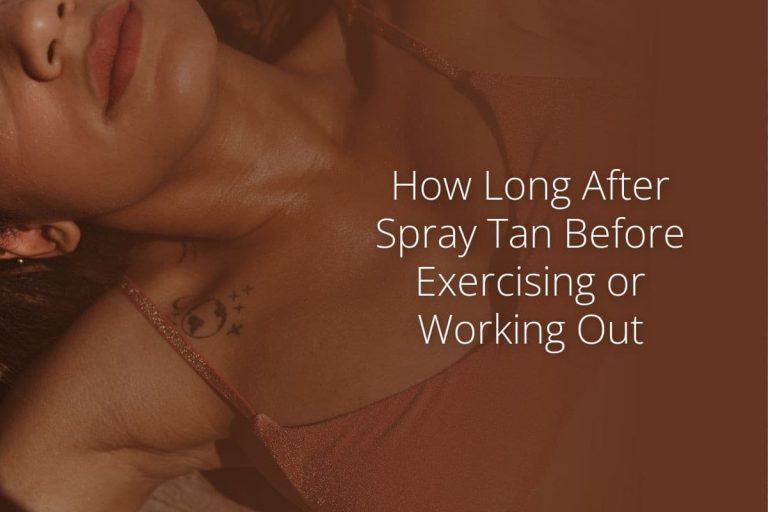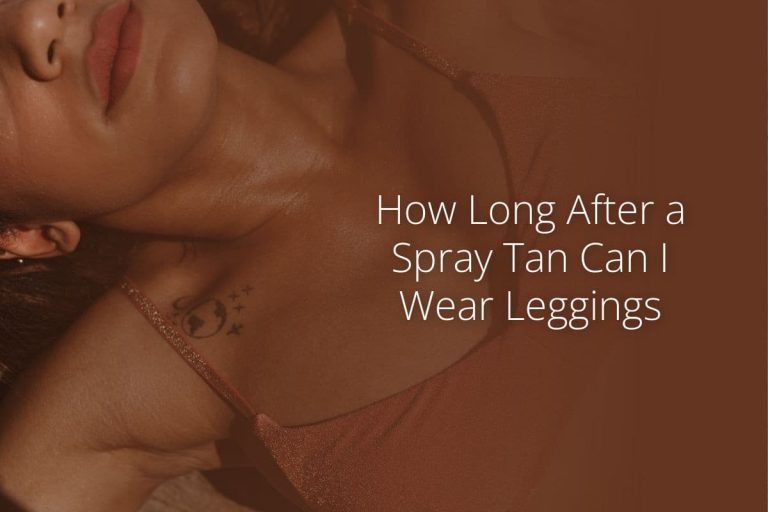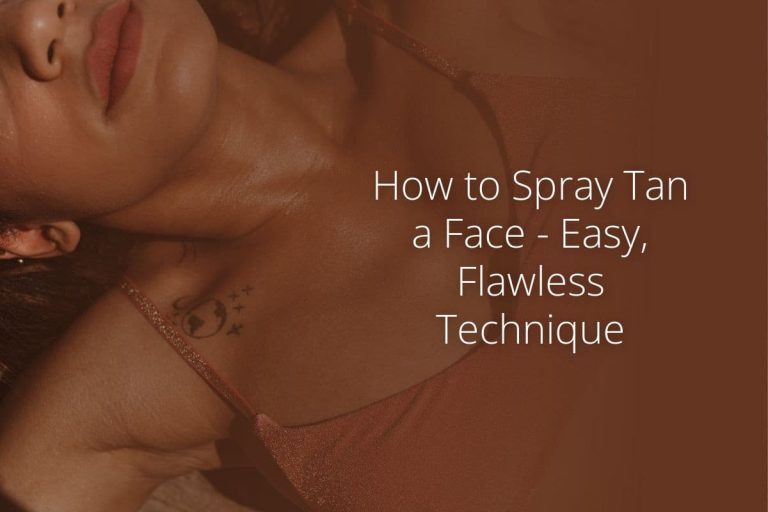
Looking for a sun-kissed glow without the harmful effects of UV rays? Say goodbye to traditional tanning methods and discover the wonders of spray tanning. This popular alternative to sunbathing offers a safe and convenient way to achieve a natural-looking tan that suits all skin types. With customizable shades, spray tans can be tailored to your desired level of bronzed perfection. Spray tanning is available at salons and can be enhanced with moisturizer for optimal results.
Spray tanning products, like bronzers, available at reputable salons, provide temporary results that rival those achieved through exposure to the sun or tanning beds. By avoiding harmful UV rays, you minimize the risk of skin cancer while still enjoying a flawless tan. Self-tanning creams and moisturizers have come a long way in recent years, making it easier than ever to achieve that coveted golden hue.
How Does Spray Tanning Work?
Spray tanning is a popular way to achieve a sun-kissed glow without exposing your skin to harmful UV rays. But have you ever wondered how it actually works at a salon? Let’s dive into the details and uncover the science behind spray tanning, including the cost and benefits of this self-care day.
When you visit a salon for a spray tan, a fine mist of tanning solution is applied onto your skin, giving it a golden glow. This solution contains DHA, an active ingredient derived from sugar cane or sugar beets, which has been approved by the FDA for use in cosmetic products. The cost of the spray tan will depend on the salon and the level of service you choose.
Once the tanning solution from the salon comes into contact with your skin, the DHA reacts with the amino acids present in the top layer of your skin, resulting in a temporary darkening of your skin tone. This reaction, known as the Maillard reaction, gives your skin a golden glow. It’s important to note that this change only affects the outermost layer of your self and does not penetrate deeper.
The result of using self tanning lotions or spray tanning products is what gives you that beautiful bronzed look after a session in a tanning bed or at a tanning salon. The depth of color can vary depending on factors such as the concentration of DHA in the solution and how long it is left on your skin before being washed off.
Typically, spray tans from tanning products last around 5 to 10 days before gradually fading away. As your skin naturally exfoliates over time, the outermost layer sheds off, taking the tanned color from self tanning lotions with it. To maintain your desired tan, you may need to schedule regular touch-up sessions at a tanning salon or in a tanning bed.
One advantage of spray tanning is that it provides an even application across all areas of your body, including hard-to-reach places like your back. Unlike traditional self-tanners that require manual application and blending, spray tans ensure a more uniform result.
It’s worth noting that while spray tans, tanning products, offer temporary results, they do not provide any protection against the sun’s UV rays. It’s still crucial to wear sunscreen when spending time outdoors to protect your skin from potential damage. Self tanning lotions can be a great alternative.
The Science Behind Spray Tanning
Spray tanning has become a popular way to achieve a sun-kissed glow without the harmful effects of UV radiation. But how does spray tanning work? Let’s dive into the science behind this bronzing method and uncover the secrets behind that beautiful, golden tan.
DHA (dihydroxyacetone) is the key component responsible for color development in spray tanning. Derived from sugar cane or sugar beets, DHA is FDA-approved for external use. When applied to the skin, it undergoes a chemical reaction with proteins in the outermost layer of dead skin cells.
This interaction between DHA and skin cells is what produces the browning effect we associate with a self tanning. As DHA penetrates the outer layer of dead skin cells, it reacts with amino acids in the proteins present. This process leads to the formation of melanoidins, which give our skin that desirable tan appearance from a tanning spray.
The reason why only dead skin cells are affected by spray tanning is because DHA cannot penetrate live cells. This makes spray tans temporary since our skin naturally sheds dead cells over time. On average, our body sheds about 30,000 to 40,000 dead skin cells every minute! As these old cells slough off, so does our spray tan.
It’s important to note that while spray tanning provides a temporary cosmetic effect, it does not offer any protection against harmful UV rays from the sun. Therefore, it’s still crucial to apply sunscreen when spending time outdoors to reduce your risk of sunburn and potential long-term damage like premature aging and even cancer.
While there is no evidence suggesting that self tanning with DHA causes cancer when used externally as intended in spray tans, it’s always wise to take precautions and protect your skin from excessive sun exposure.
One of the advantages of spray tanning is its ability to provide instant results without exposing yourself to harmful UV radiation. Unlike traditional tanning methods that require hours of sunbathing, spray tans can be achieved in a matter of minutes. This makes it a convenient option for those who want a quick and safe way to achieve a sun-kissed look.
Key Ingredients in Spray Tanning Solutions
Spray tanning has become increasingly popular as a safe and convenient alternative to traditional sunbathing or tanning beds. But have you ever wondered how spray tanning actually works? The secret lies in the key ingredients found in the tanning solutions.
DHA: The Main Active Ingredient
Dihydroxyacetone (DHA) is the main active ingredient in most spray tanning solutions. It is a colorless sugar that interacts with the amino acids present in the outermost layer of our skin, known as the stratum corneum. When DHA comes into contact with these amino acids, it undergoes a chemical reaction called the Maillard reaction, resulting in a temporary browning effect on the skin’s surface.
Unlike UV rays from the sun or tanning beds that penetrate deeper layers of the skin, DHA only affects the topmost layer, which means it does not damage your skin cells or increase your risk of developing skin cancer.
Erythrulose: Longer-Lasting Results
Erythrulose is often used alongside DHA in spray tanning solutions to achieve longer-lasting results. Similar to DHA, erythrulose reacts with amino acids on the skin’s surface but at a slower rate. This gradual reaction helps extend the life of your tan by allowing it to develop more evenly and fade more naturally over time.
By combining both DHA and erythrulose, self tanning spray can last anywhere from five to ten days before gradually fading away. However, it’s important to note that individual results may vary depending on factors such as skincare routine and exfoliation habits.
Aloe Vera: Hydration and Soothing Benefits
To ensure a smooth and comfortable application process, many spray tanning solutions incorporate aloe vera as an essential ingredient. Aloe vera is well-known for its moisturizing properties, helping to hydrate and soothe the skin during and after the tanning session.
By keeping the skin adequately moisturized, aloe vera helps prevent the tan from appearing patchy or uneven. It can alleviate any potential dryness or irritation that may occur due to the tanning process.
Antioxidants: Added Benefits
Some spray tanning solutions also include antioxidants for their potential anti-inflammatory benefits. These powerful compounds help protect your skin against free radicals and reduce inflammation caused by exposure to UV radiation.
Antioxidants like vitamin E and green tea extract can enhance the overall health of your skin while providing an extra layer of protection. However, it’s important to remember that self tanning sprays are not a substitute for sunscreen, so always apply SPF before going out in the sun.
Understanding DHA in Spray Tanning
DHA, short for dihydroxyacetone, is a key component in spray tanning products. Derived from natural sources like sugar cane or sugar beets, DHA offers a safe and effective way to achieve that sun-kissed glow without the harmful effects of UV radiation.
DHA works its magic by reacting with amino acids present in the outermost layer of your skin called the stratum corneum. This reaction triggers a chemical process leading to the production of melanoidins, which ultimately results in a tan appearance.
Unlike traditional tanning methods that involve exposure to sunlight or tanning beds, DHA does not penetrate beyond the stratum corneum. This makes it perfectly safe for external use and eliminates any risk of damage to deeper layers of your skin.
The interaction between DHA and amino acids occurs on the surface of your skin. As you apply a spray tan solution containing DHA, it creates an instant color change due to this reaction. However, keep in mind that this initial color is not the final result. Over time, usually within 6-8 hours after application, the full depth of color develops as the melanoidins continue to form.
One advantage of using DHA-based spray tans is their ability to provide customizable results. The concentration of DHA determines how intense your tan will be. Higher concentrations typically lead to darker shades while lower concentrations offer more subtle results. This allows individuals to choose a shade that suits their preferences and desired level of tan.
It’s worth noting that everyone’s skin reacts differently to DHA-based products. Factors such as skin type, pH levels, and individual variations can influence how quickly and deeply the color develops. To ensure optimal results, it’s advisable to exfoliate before applying a spray tan and moisturize regularly afterward.
Another benefit of using spray tans with DHA is their temporary nature. As your skin naturally sheds dead cells from the stratum corneum, the tan gradually fades away. On average, a spray tan lasts around 7-10 days before it completely disappears. To maintain your desired level of tan, periodic reapplication is necessary.
Preparing for a Spray Tan Session
Before you head to the salon for your spray tan session, there are a few important steps you should take to ensure that you get the best results possible. Follow these guidelines to prepare your skin and make the most out of your appointment.
Exfoliate Your Skin
To achieve an even and long-lasting tan, it’s crucial to exfoliate your skin before the session. This helps remove dead skin cells and any dry patches, allowing the tanning solution to be applied smoothly. Use a gentle scrub or exfoliating mitt in the shower, focusing on areas like elbows, knees, and ankles that tend to be drier. By sloughing off these dead cells, you’ll create a smooth canvas for the spray tan solution.
Avoid Moisturizers and Makeup
On the day of your spray tan appointment, it’s essential to avoid applying any moisturizers, oils, or makeup. These products can create a barrier on your skin, preventing the tanning solution from properly adhering. Opt for clean and bare skin so that the bronzer can develop evenly across all areas. If you have sensitive skin or are prone to breakouts, consult with your technician about suitable products that won’t interfere with the tanning process.
Wear Loose-Fitting Clothing
After getting a spray tan, it’s crucial to wear loose-fitting clothing to prevent rubbing off the tanning solution. Tight clothes can cause friction against your freshly bronzed skin and potentially result in streaks or unevenness. Choose comfortable attire like flowy dresses or loose pants paired with a breathable top. By opting for loose-fitting garments, you’ll minimize contact between your clothes and newly applied tan.
Remove Jewelry and Accessories
Before stepping into the spray booth or getting sprayed by a technician, remember to remove any jewelry or accessories that may interfere with the application process. Necklaces, bracelets, rings, and even watches can create obstacles for the fine mist of tanning solution to reach your skin properly. By taking off these items, you’ll ensure that every part of your body receives an even coat of the bronzing spray.
By following these preparation tips, you’ll be well on your way to achieving a flawless summer glow with your spray tan. Remember to exfoliate beforehand, avoid moisturizers and makeup on the day of your session, wear loose-fitting clothing afterward, and remove any jewelry or accessories that may hinder the application process. These simple steps will help you make the most out of your appointment at the salon and leave you with a beautiful golden glow that lasts.
Applying Spray Tan: Techniques and Equipment
Spray tanning has become a popular alternative to traditional sunbathing or tanning bed sessions. It offers a quick and convenient way to achieve a sun-kissed glow without the harmful effects of UV radiation. But how does spray tanning work? Let’s dive into the techniques and equipment used for applying spray tan.
Manual Application with Airbrush Technique
One method of applying spray tan is through manual application using an airbrush gun. This technique involves a trained technician who carefully sprays the tanning solution onto the client’s skin using an airbrush gun. The airbrush allows for precise application, ensuring even coverage on all areas of the body.
The advantage of the airbrush technique lies in its ability to customize the color according to individual preferences. The technician can adjust the intensity of the tan by controlling factors such as pressure, distance, and amount of solution sprayed. This level of customization ensures that clients achieve their desired shade, whether it be a subtle glow or a deep bronzed look.
Automated Booths for Consistent Coverage
Another method commonly used for spray tanning is through automated booths. These booths are equipped with nozzles that release a fine mist of tanning solution onto the client’s body. While they lack the precision offered by manual application, automated booths provide consistent coverage across all areas.
To ensure an even tan when using an automated booth, it is important to follow certain precautions. Clients should carefully read and adhere to any instructions provided by the booth manufacturer or operator. Preparing the skin by exfoliating beforehand helps remove dead skin cells and promotes an even application.
Ventilation: A Crucial Factor
Regardless of whether you choose manual application or opt for an automated booth, proper ventilation during spray tan application is crucial. The tanning solution contains active ingredients such as DHA (dihydroxyacetone), which reacts with the outermost layer of the skin to produce a temporary tan. Inhalation of these chemicals should be minimized to ensure safety.
Technicians performing manual spray tans should work in well-ventilated areas or use ventilation systems to reduce the risk of inhaling excessive amounts of tanning solution. Automated booths often have built-in ventilation mechanisms, but it is still advisable to take precautions and avoid breathing in the mist directly.
Maintaining and Enhancing Your Spray Tan
Moisturize regularly with oil-free products to prolong the life of your spray tan
To keep your spray tan looking fresh and vibrant, it’s important to moisturize regularly. However, not all moisturizers are created equal. Opt for oil-free products that won’t interfere with the tanning solution or cause any streaking or discoloration.
Moisturizing helps lock in moisture and prevent dryness, which can lead to premature fading of your tan. Look for lightweight lotions or creams that absorb quickly into the skin without leaving a greasy residue. Apply the moisturizer daily, focusing on areas prone to dryness such as elbows, knees, and ankles.
Avoid excessive exfoliation as it can cause premature fading of the tan
Exfoliation is an essential part of any skincare routine, but when you have a spray tan, it’s crucial to be mindful of how often you exfoliate. Excessive exfoliation can strip away dead skin cells along with your tan, causing it to fade more quickly than desired.
Instead of using harsh scrubs or loofahs, opt for gentle exfoliating gloves or a soft washcloth when showering. This will help remove any dead skin cells without being too abrasive on your tan. It’s also important to avoid exfoliating immediately after getting a spray tan as this can disrupt the development process.
Pat dry after showering instead of rubbing vigorously with a towel
After showering, how you dry off can make a difference in maintaining your spray tan. Instead of vigorously rubbing yourself with a towel, gently pat yourself dry. Rubbing too aggressively can cause friction and potentially remove some of the tanning solution.
Be sure to use a clean towel each time you shower to avoid any potential transfer of color from previous tans or residual tanning solution. Patting yourself dry helps to minimize the risk of streaking or uneven fading.
Use gradual tanning lotions or sprays to touch up any areas that may have faded unevenly
Even with proper care, spray tans can fade unevenly over time. To touch up any areas that may have lost their color, consider using gradual tanning lotions or sprays. These products allow you to build up your tan gradually and blend seamlessly with your existing tan.
When applying a gradual tanning lotion or spray, start with a small amount and gradually build it up until you achieve the desired color. This will help avoid any sudden changes in shade and ensure a natural-looking result.
Conclusion
In conclusion, spray tanning is a popular method for achieving a sun-kissed glow without the harmful effects of UV radiation. By understanding how spray tanning works and avoiding common mistakes, you can ensure a flawless and long-lasting tan.
The science behind spray tanning involves the use of DHA, a key ingredient in spray tan solutions. When applied to the skin, DHA reacts with the amino acids in the top layer of your skin to produce a temporary tan that typically lasts for about 7-10 days.
To prepare for a spray tan session, it’s important to exfoliate your skin beforehand to remove any dead cells and create an even surface for the tanning solution. You should avoid applying any moisturizers or oils before your session as they can interfere with the absorption of the solution.
When applying the spray tan, proper techniques and equipment are crucial. It’s important to evenly distribute the solution using sweeping motions and pay close attention to areas such as elbows, knees, and ankles which tend to absorb more color. Using barrier cream on nails and palms can also prevent them from staining.
Maintaining and enhancing your spray tan requires some care. Moisturizing daily helps prolong its lifespan while avoiding excessive exfoliation or swimming in chlorinated water can prevent premature fading. There are also products available that can help enhance your tan by providing additional color or shimmer.
In order to achieve the best results with your spray tan, it’s essential to follow these guidelines carefully. By doing so, you’ll be able to enjoy a natural-looking tan that boosts your confidence and gives you that healthy glow.
So why wait? Say goodbye to harmful UV rays and embrace the beauty of spray tanning today!
FAQs
Can I shower immediately after getting a spray tan?
It is recommended to wait at least 8-12 hours before showering after getting a spray tan. This allows enough time for the DHA to fully develop and provide a long-lasting tan.
Will spray tanning make me look orange?
No, when done correctly, spray tanning should not make you look orange. The key is to choose the right shade for your skin tone and follow the application instructions carefully.
How long will my spray tan last?
On average, a spray tan can last anywhere from 7-10 days. However, factors such as your skincare routine and activities like swimming or exfoliating can affect its longevity.
Can I apply makeup over my spray tan?
Yes, you can apply makeup over your spray tan. Just make sure to use oil-free products and avoid heavy exfoliation that could cause patchiness.
Is spray tanning safe for pregnant women?
While there is no definitive answer, many pregnant women opt for spray tans as a safer alternative to UV exposure. It’s always best to consult with your healthcare provider before trying any new beauty treatments during pregnancy.






